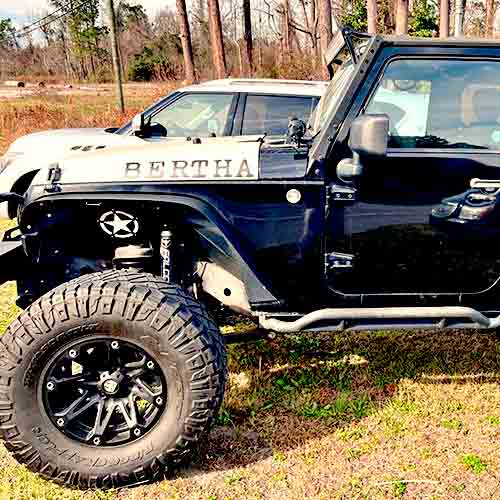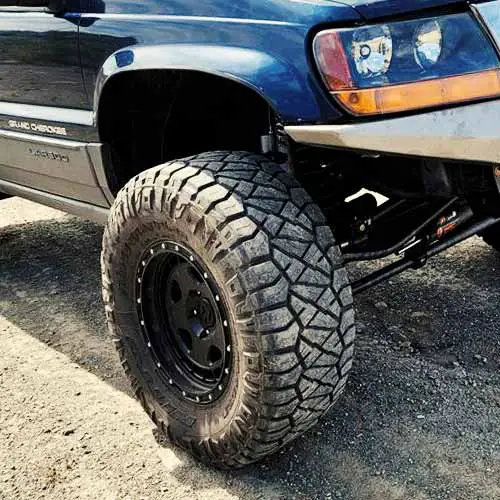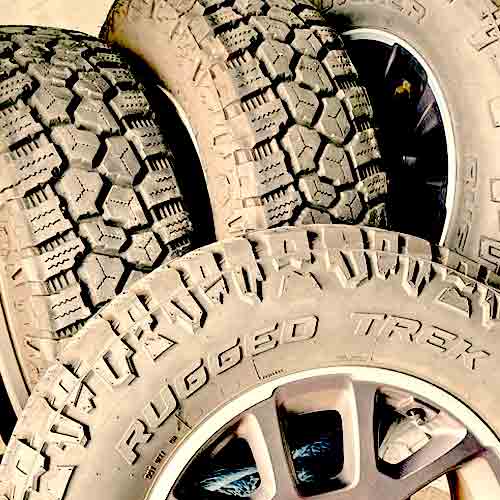Both the Cooper Discoverer Rugged Trek and the Nitto Ridge Grappler are hybrid terrain tires, used for multiple driving conditions, it doesn’t matter whether they are off road, on beaten paths or just providing the daily commute. Though there are some things to consider while looking at both. Let’s check them out.

Being a tire engineer, from my perspective, Cooper Discoverer Rugged Trek provides a better pavement traction (on both wet and dry environments), where its fuel and tread wear is also worth noting. The Nitto Ridge Grappler on the other side, provides superior traction on rocks and offers great on road stability. Though its sand and mud performance is almost on par to its competitor.
Review Nitto Ridge Grappler here: https://tiredriver.com/nitto-ridge-grappler-review/
Table of Contents
Tire Sizes
The Nitto Ridge Grappler offers 98 total sizes, in 16 to 24 inches, with following specs:
- Load ratings available: SL, XL, D, E and F.
- Speed ratings available: T or Q.
- Weight range : 36 lbs to 91 lbs.
- Tread depth range: 13/32″ to 18/32″ (Most common: 16.4/32″).
- Sizes have no mileage warranty or 3PMSFR.
Cooper Rugged Trek offers…
- 18 total sizes in 16″ to 20″ (rim diameter).
- All have speed ratings in either T or Q.
- Load ratings are available in only XL, E and F, where 265/70R16 and 275/60R20 (only two sizes) also have SL range.
- Tire weight goes form 40 lbs to 70 lbs.
- Tread depth: Either 16/32″ or 18.5/32″.
- All sizes have 3pmsfr.
- LT sizes have 55k miles warranty, while others have 65k.
Tread Structure
The Nitto Ridge Grappler has a very interesting tread design, let’s consider it’s central part first.

Here, you see four triangular blocks, where the two on sideways having notches (facing the shoulder voids).
While the remaining two lugs (in the central most rib), posses the rest of the features. They have sharp edges, full depth siping, and foundational supports underneath.
All these blocks, collectively create X and Z shaped grooves in the center, as well as zigzag longitudinal surrounding circumferential channels, which divide the outer blocks from them.
Speaking of which, shoulder lugs carry little overall tread features, and siping, making slightly less aggressive pattern from the middle.
Nonetheless, the tire really makes up for it with it’s outer edges, where you see powerful mud scoops and thicker sidewalls lugs.
On the other side, the tread of Cooper Rugged Trek is also pretty aggressive, lets start things from the middle on this tire too.

So here lugs are slightly more packed up together, and this makes them have a dual functionality in terms of traction.
Off-road, with their sharp edges, interlocking sipes, and ridges (which provide biters), you get epic crawling abilities on rocks, mud and sand. And at the same time with the closeness of these lugs, and longitudinal orientation (making 3 vertical channels), they also yield highways stability as well.
Moving toward the shoulders, the tread gets to be very wild, and that explains why the lateral traction of this tire on roads isn’t that great, even though the lugs have reinforced foundations, as they are sitting/attached on stone ejectors coming underneath. But that is done to provide amazing off-road bite, and the tire shines there, no doubt.
The countless ejectors don’t let any debris to settle in and the staggered scoops of the shoulders combined with aggressive dual sidewall lug provide amazing traction values specifically when you air down the tire to a lower PSI value.
Durability
The durability of off-road tires is a crucial aspect as they are subjected to “puncturing” terrains.
This necessitates the incorporation of cut-resistant rubber and deep tread voids in almost all off-road tires. Though the main sturdiness of a tire, is determined by the internal construction, particularly the sidewalls, which really makes all-terrain tires worth it for off-road use.
That’s why Cooper Discoverer Rugged Trek with just 2 ply polyester casing, and 2 cap plies of nylon doesn’t provide as good a durability as its competitor.
Nitto Ridge Grappler features a powerful combination of 3 ply polyester cover, 2 wide steel belts (covering the central part of the tread, underneath), and 2 layers of nylon as cap plies.
Highway Traction
In order to accurately explain the traction capabilities of these tires, I’ve made a technical analysis of their grip, handling and steering response. Let me explain.
Directional Grip
This type of grip depends on the footprint of the tire from the middle, as moving straight or should I say directionally, a tire allocates more pressure to it’s central lugs forming a solid connection from there.
And so with a more compact design in comparison, you see a better performance on Cooper Rugged Trek (it shows shorter braking distances when fully stopped form 50 mph).
The Nitto Ridge Grappler on the other hand falls short dues to it’s Z shaped grooves, breaking the rubber to road connection more frequently in comparison.
For Your Info: In my list of top A/T tires, I rated Continental TerrainContat A/T best for highways.
Lateral Traction
The weight transfer to the shoulders during turns emphasizes the importance of the outer lugs meeting with the ground. So how they connect with the surface is very crucial for lateral traction.
And here although both tires, are pretty voided, you still see a better capability on Nitto Ridge Grappler. This is mainly because of 2 things.
- The tire has less tread features, so they provide smoother rubber to road connection, and two, the tire’s overall tread has a stiffer composition.
- With reinforced foundations underneath those lugs, they create better maneuvering stability, which has to do with steering response.
The Cooper Rugged Trek on the other side, is although lighter in weight, it’s softer compound still bends the lugs more comparatively, so you get slower steering response.
Though as the difference between them is very small, you get similar speed ratings on both.
Wet Performance
A secure grip on wet roads is achieved through the effective integration of siping and flexibility. These two features work hand in hand to quickly remove water from the tread at a micro level.
Most of the water is let out form the tread with the help of grooves, and the little that’s left behind is dealt with these tiny slit on the tread which are known as sipes.
When meeting with water, they expand to let the air out, creating suction for the water particles coming underneath, clearing them to form stable tread connection with the ground.
That’s why the Cooper Rugged Trek with it’s softer tread composition, allowing sipes to flex more, provide better traction values.
The Nitto Ridge Grappler on the other hand, not only has a harder compound, it’s siping structure is not not that effective. As they are rectilinear, they don’t get to bend that much when the tread is under stress, i.e while cornering and braking.
Though it still provides ample traction values when it comes to hydroplaning resistance.
Fuel Consumption
Even though the Cooper Discoverer Rugged Trek gets to be pretty bald, it’s still consumes less fuel in comparison, thanks to it’s much lighter structural weight which reaches only up to 70 lbs with F load ratings.
In comparison, the Nitto Ridge Grappler with it’s extra weight, going up to 90 pounds would compress and rebound (as an effect) with greater force, wasting energy in to rolling friction.
Tread Wear
The life of a tire’s tread is impacted by a combination of three key factors – rolling resistance, tread depth, and composition. That’s the reason why tires with deeper tread voids, lighter structure, and a stiff composition last longer.
So it makes sense why the Cooper Discoverer Rugged Trek shows up with slower tread wear. It’s 70 pounds of weight does not emphasis a lot of weight-pressure on the blocks, and so they rub off the surface with smaller force.
Nitto Ridge Grappler on the other side, although has a harder compound, and similar tread depth compared to Cooper, it’s larger structure, still wears faster.
For Your Info: If you are wondering how tread depth helps here, just keep in mind, the deeper the tread voids, the longer it would take to reach down to 2/32″, which is the legal limit with which you can drive in US. Though you can always increase your tire’s tread life.
Tread Noise
With Cooper’s “Whisper Grooves Technology”, the Rugged Trek even with it’s wider tread voids there, gets to be quieter in comparison (but only marginally).
This is because noise is just air particles hitting the walls of the tread, and as most of that air comes in through the shoulders voids, the Cooper RT cuts the noise down at the source, by placing ridges between the shoulder blocks, restricting the flow of air.
Nitto Ridge Grappler on the other hand, lets more air to come in, though the tire is still very quiet, thanks to it’s variable pitch technology. It creates different pitches and tones (when air particles hit the tread blocks), and they don’t get to amplify.
I talked about it more in, noise on all-terrain tires.
Winter Capabilities
Winter traction is evaluated based on a tire’s ability to grab the snow particles in grooves, and that’s why Cooper Discoverer Rugged Trek provides better traction here, and is branded with 3 peak mountain snowflake rating unlike its counterpart.
The tire’s greater in number (interlocking) sipes, stone ejectors and “snow” vices (saw toothed edges seen on outer longitudinal grooves), all provide holding on to the snow, and making snow to snow contact with it.
Nitto Ridge Grappler in comparison, not only lacks in sipes, but is also more susceptible to getting stiffer with its harder compound composition, limiting winter performance.
Mud Performance
Mud is a toughest challenge of all. That’s why we have tires named after them, “mud-terrain”, and what makes them great are their balder design.
Though hybrid tires, like these two over here, having mud terrain shoulder lugs also do pretty great.
The Cooper Rugged Trek has very wide shoulder voids with a lot of stone ejectors embedded in them, and they don’t allow any dirt particle to get settled in (too easily).
Whereas on Nitto Ridge Grappler you get a combination of X and Z shaped grooves connecting every part of the tread, so mud has no problem leaving the tread in this tire’s case as well.
So overall, although traction wise both tires are same, you can still put Nitto above, based on it’s greater durability.
Traction on Rocks
On rocky terrains, a tire needs a solid sticking power in both vertical and horizontal directions, along with a powerful durability.
That’s why out of both the Nitto Ridge Grappler does better here.
Actually in the A/T category, it’s one of the best for rocks. (I rated the tire for this, in my list of top all-terrain tires).
The triangular blocks in the middle with sharp edges, notches, (full depth) siping, and off-sets (saw-tooth edges) supply grip at multiple angles, and with dual sidewalls having chunkier lugs on top, you get superb grabbing power especially with lowered air pressure.
The Cooper Discoverer Rugged Trek, on the other hand, although does provide great directional grip (during climbing), due to it’s lighter weight, softer compound (which sticks), and bigger groove mouth (on shoulders), it’s lateral traction is lacking here overall, and the tier does not provide ample durability with just 2 ply sidewalls.
Grip on Sand
To improve a tire’s performance on sand, it’s important to reduce its air pressure. This creates a “floating” effect, making the tire better suited for soft surfaces. Though there are some tread features which further aid to that.
And all of them are seen better on Cooper Discoverer Rugged Trek. This tire for one has a softer compound, so with lowered air pressure, it’s lugs better mold with the sand. Moreover, you also get softer edges, and thick enough sidewall lugs which spread out to provide extra contact patch (which enhances floating on the ground).
And above all, the tire is very lighter in weight, (its almost 20 pound lighters, comparing heaviest sizes of both tires), so it avoid digging in a much better way.
Nitto Ridge Grappler on the other side, although features greater durability with 3 ply sides, it’s heavier weight combined with sharper stiff sides (due to it’s harder tread compound), does not provide as better of a sand traction as the Cooper RT.
Check out-
Are All-Terrain Tires Good On Sand? : https://tiredriver.com/are-all-terrain-tires-good-on-sand/
Take Home Points
Cooper Discoverer Rugged Trek has a rugged terrain skin on top, but from inside, it’s a weaker tire, yet it still performs better on mud and sand, and with a lighter structure is good with fuel and tread wear.
Nitto Ridge Grappler on the other side, does great on rocky terrains, and provides amazing stability of dry roads, though it’s wet traction could use some help.